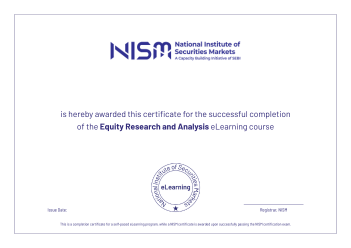Equity Research and Analysis

The Equity Research and Analysis Course is designed to empower learners with the skills and knowledge required to excel as research analysts in the financial markets.
The course offers comprehensive coverage of key topics, including:
- An overview of the Indian securities markets
- Fundamental and advanced research methodologies
- Macro and microeconomic analysis for market insights
- In-depth company analysis and valuation techniques
- Understanding risk, returns, and corporate actions
- Regulatory frameworks and professional research report writing
By the end of the course, learners equipped with a solid foundation to thrive in securities market analysis and drive professional success
₹ 500/-
This course includes:
3 Hours of learning content
1 Month access
Completion Certificate
English
Who Should Take This Course?
This course is ideal for individuals seeking to understand the core principles of equity research and analysis in a concise, structured format. The course is designed to build the capacity of
Aspiring Research Analysts
Finance Professionals and Investors
Financial Advisors and Wealth Managers
Individual Investors and Traders
Students aspiring for a career in Securities Markets
Offered by: NISM
Assessment Test: Yes
Pass Percentage - 60%
What’s In It For You?
- Primary role of research analyst
- Primary responsibilities of research analyst
- Basic principles of interaction with companies and clients
- Important Qualities of a research Analyst
- Introduction to Securities and Securities Market
- Product Definitions / Terminology
- Structure of Securities Market
- Various market principals and their activities
- Kinds of transaction
- Dematerialization and rematerialization of securities
- Terminology in Equity Market
- Terminology in Debt Market
- Types of Bonds
- What is Investing?
- The role of research in investment activity
- Technical Analysis
- Fundamental Analysis
- Quantitative Research
- Behavioural Approach to Equity Investing
- Basic Principles of Microeconomics
- Basic Principles of Macroeconomics
- Introduction to Various Macroeconomic Variables
- Role of economic analysis in fundamental analysis
- Secular, cyclical and seasonal trends
- Sources of Information for Economic Analysis
- Role of industry analysis in fundamental analysis
- Defining the industry
- Understanding industry cyclicality
- Market sizing and trend analysis
- Secular trends, value migration and business life cycle
- Understanding the industry landscape
- Key Industry Drivers and Industry KPIs
- Regulatory environment/framework
- Taxation
- Sources of information for industry analysis
- Role of company analysis in fundamental research
- Understand Business and Business Models
- Pricing Power and Sustainability of This Power
- Competitive Advantages/Points of differentiation over the Competitors
- Strengths, Weaknesses, Opportunities and Threats (SWOT) Analysis
- Quality of Management and Governance
- Structure
- Risks in the Business
- History of credit rating
- ESG framework for company analysis
- Sources of Information for Analysis
- Introduction to financial statement
- Stand-alone financial statement and consolidated financial statement
- Balance Sheet
- Basics of Profit and Loss Account (P/L)
- Statement of changes in shareholder’s equity
- Basics of Cash Flows
- Notes to accounts
- Important Points to Keep in Mind While Looking at Financials
- Reading audit report to understand the quality of accounting
- Financial statement analysis using ratios
- Commonly used ratios
- Dupont analysis
- Forecasting using ratio analysis
- Peer Comparison
- Other aspects to study from financial reports
- Philosophy of Corporate Actions
- Dividend
- Rights Issue
- Bonus Issue
- Stock Split
- Share Consolidation
- Merger and Acquisition
- Demerger / Spin-off
- Scheme of arrangement
- Loan Restructuring
- Buyback of Shares
- Delisting and relisting of Shares
- Share Swap
- Difference between Price and Value
- Why Valuations are required
- Sources of Value in a Business – Earnings and Assets
- Approaches to valuation
- Discounted Cash Flows Model for Business Valuation
- Relative valuation
- Earnings Based Valuation Matrices
- Assets based Valuation Matrices
- Relative Valuations – Trading and Transaction Multiples
- Sum-Of-The-Parts (SOTP) Valuation
- Other Valuation Parameters in New Age Economy and Businesses
- Capital Asset Pricing Model
- Objectivity of Valuations
- Some Important Considerations in the Context of Business Valuation
- Concept of Return of Investment and Return on Investment
- Calculation of Simple, Annualized and Compounded Returns
- Risks in Investments
- Measuring risk
- Concepts of Market Risk (Beta)
- Sensitivity Analysis to Assumptions
- Concept of Margin of Safety
- Comparison of Equity Returns with Bond Returns
- Calculating risk adjusted returns
- Basic Behavioural Biases Influencing Investments
- Some Pearls of Wisdom from Investment Gurus across the World
- Measuring liquidity of equity shares
- Qualities of a Good Research Report
- Checklist Based Approach to the Research Reports
- A Sample Checklist for Investment Research Reports
- Regulatory infrastructure in Financial Markets
- Important regulations in Indian Securities Market
- Code of Conduct for Research Analysts
- Management of Conflicts of Interest and Disclosure Requirements for Research Analysts
- Exchange surveillance mechanisms: GSM and ASM
Looking for Help?
Helpdesk
02192-668492/8493
Timings: Monday to Friday 9:30 AM till 5:30 PM
(Helpdesk will remain closed on public holidays).
elearning@nism.ac.in
